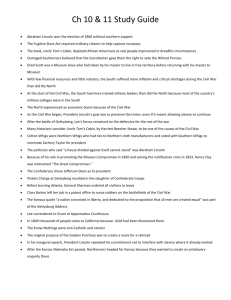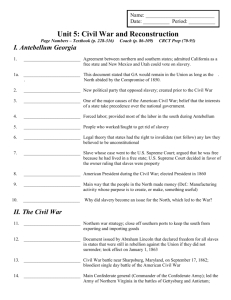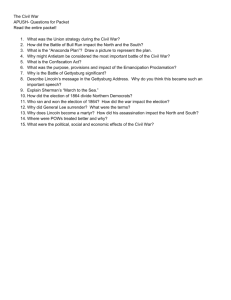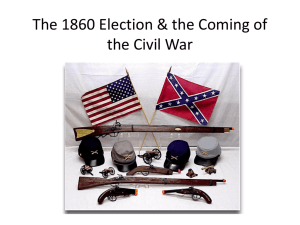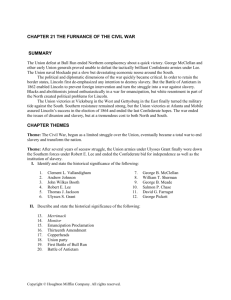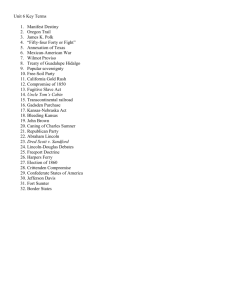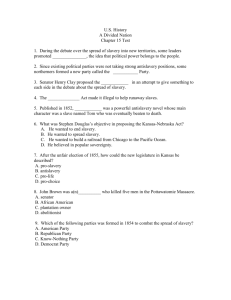United States History - Honors
advertisement
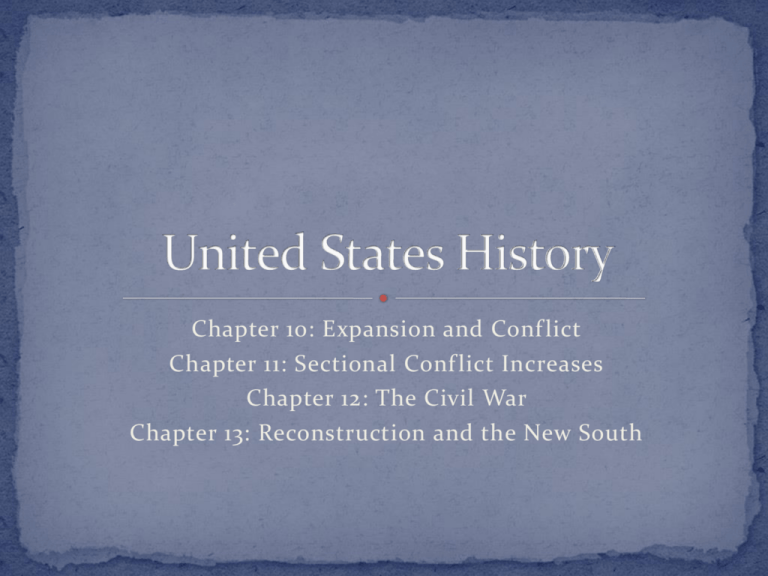
Chapter 10: Expansion and Conf lict Chapter 11: Sectional Conf lict Increases Chapter 12: The Civil War Chapter 13: Reconstruction and the New South As the 1800s pressed on, many Americans began to buy into the belief of manifest destiny God intended the nation to expand from coast to coast Would open up settlement to more people, getting away from crowded eastern cities However, other nations laid claim to most lands west of the Mississippi River Texas: originally part of Mexico, who had gained independence from Spain Mexico opened settlement in Texas to Americans However, the area was overrun by Americans, many of whom wanted to form their own nation, free of Mexican control War broke out between Mexico and Texas Most famous battle happened at the Alamo in San Antonio, were hundreds of Texans were killed Used the Alamo as the battle cry to defeat Mexico Led by Sam Houston, the Texans prevailed and declared the independent Republic of Texas in 1836 Tensions between Texas and Mexico ran high for years after the war The United States and Texas both expressed interest in making Texas a part of the United States James K. Polk ran for president in 1844 on a platform calling for the annexation After winning, the annexation was signed in March 1845 Mexico broke off diplomatic relations with the United States Tensions furthered when Polk sent troops to the Rio Grande, insisting that it was the border Mexico recognized the Nueces River, miles north of the Rio Grande, as the legal border On May 9, 1846, Mexican troops crossed the river and attacked American troops Polk encouraged Congress to declare war on May 13 The short war would greatly change the makeup of the North American continent Troops were mobilized to attack various areas of Mexico Gen. Zachary Taylor invaded central Mexico Gen. Stephan Kearny took New Mexico and turned his attention to California Capt. John C. Fremont led a revolt of settlers in Northern California that became known as the Bear Flag Revolt in June 1846 California was under American control by Jan. 1847 Northern Mexico was also defeated quickly, by Feb. 1847 The final battle would see Mexico City fall to the Americans in Sept. 1847 Invasion at Veracruz, led by Gen. Winfield Scott Pressed across Mexico, forcing surrender of Mexico City on Sept. 14 Ended by the Treaty of Guadalupe Hidalgo Gave the US all territory west of Mississippi River under Mexican control US paid Mexico $15 million In 1853, the US purchased land of Arizona and New Mexico in the Gadsden Purchase for $10 million There were many reasons for people to move west Promise of land Religious freedom Mineral wealth Traveled over many routes to get to the west Santa Fe Trail: Independence, MO to Santa Fe, NM Oregon Trail: Independence, MO to Portland, OR Old Spanish Trail: Santa Fe, NM to Los Angeles, CA Mormon Trail: Illinois to Salt Lake City, UT Many struggles along the routes Weather and trail conditions (Donner Party, 1846-47) Conflict with Native Americans Promised with Treaty of Fort Laramie to respect tribes and settlers, while paying tribes each year (another broken promise) In 1848, near present day Sacramento, John Sutter found gold in the American River Sparked an epic rush of settlers to California hoping to strike it rich Settlers were called forty-niners Most were unsuccessful, but some did strike it rich Towns and mining camps sprung up overnight Most settlers were young unmarried men Supplies were expensive Crime, drinking, gambling, fighting, and prostitution were rampant in the camps Chinese and Native American workers were exploited for cheap labor and forced them off their lands, decimating the population The rush was short lived, and paled in comparison to other rushes that would eventually happen With the acquisition of all of the new lands, the question of slavery continued to persist Some insisted on expanding the Missouri Compromise line Others called for popular sovereignty, allowing residents of the territories to choose The Wilmot Proviso proposed banning slavery in all the territories, but was defeated before becoming law Most important issue of election of 1848 Whigs ran Zachary Taylor, who did not express opinion on the matter Democrats ran Lewis Cass, popular sovereignty proponent A new party, the Free Soil Party, called for banning slavery everywhere Zachary Taylor won the election, immediately having to deal with a partisan Congress on the issue Admitted CA in 1849 as a free state Daniel Webster, Henry Clay, and John C. Calhoun debated compromises in the Senate on slavery Taylor died before they were passed; his successor, Millard Fillmore, supported the measures, signing the Compromise of 1850 into law Allowed territories to choose slavery or free status With the Compromise of 1850, an intense election came in 1852 Franklin Pierce (D) and Winfield Scott (Whig) Pierce easily won, but was an ineffective president, letting slavery strengthen, not weaken, in the nation Fugitive Slave Act: made it a crime to assist runaway slaves and gave government assistance to return slaves The law outraged many, especially in the North Harriet Beecher Stowe wrote Uncle Tom’s Cabin, to high acclaim in the North, dismay in the South Kansas-Nebraska Act (1854): nullified the Missouri Compromise, giving all states and territories the choice Led to severe violence in Kansas when they petitioned to become a state Quickly became known as “Bleeding Kansas” Missouri residents poured into Kansas to vote for a pro-slavery gov’t John Brown led a raid where he murdered pro-slavery supporters Senator Charles Sumner of MA was beaten by Congressman Preston Brooks of SC for a scathing speech about the South (“Bleeding Sumner”) In 1854, the Republican Party formed as an anti-slavery party Allied with the Know Nothings to win midterm elections in 1854 Nominated John C. Fremont in 1856 for president, but was defeated by Democrat James Buchanan In Kansas, two separate governments, one pro slavery, one anti slavery, formed Pro slavery government based in Lecompton, KS Based on the Lecompton Constitution, that gave voters the right to choose whether or not to have slavery in the territory, and eventually, state Another blow to the abolitionist cause came through the Supreme Court in Dred Scott v. Sanford Scott, former slave, sued for his freedom Sanford sued to gain Scott back Court decided that Scott was to return because, as a black man, he had no rights, and was also property, so he was sent back to slavery President Buchanan supported the decision, pushing the nation closer to war Abraham Lincoln came into prominence in the late 1850s, debating Illinois Senator Stephen Douglas on several occasions in the lead up to a Senate campaign in 1858, and again in 1860 for president Lincoln lost the election in 1858, but made a name for himself that got him nominated in 1860 for president Harpers Ferry, VA, 1859 John Brown organized a raid on a federal arsenal Hoped to arm slaves to revolt Rebellion crushed, Brown executed for treason Hero to the North, devil in the South Election of 1860 Divided Democratic Party lost to Republican Abraham Lincoln Shortly after the election, 11 states seceded from the Union to form the Confederate States of America Chose Jefferson Davis as president Lincoln tried to restore the Union, but to no avail The Crittenden Compromise was one last attempt to save the Union, but was rejected Union troops stationed at Fort Sumter, SC were told to leave by Confederate forces, but refused Attacked on April 12, 1861 Fort was surrendered by the Union on April 15, 1861 First official battle of the Civil War Lincoln called for volunteers, stating that the South was in a “state of rebellion” States quickly chose sides, with 4 slave states staying in the Union Split up families, with brothers fighting on opposite sides North had more supplies, more transportation, and more troops South had cotton, fight on home turf, and better trained troops, led by Gen. Robert E. Lee The first major battle after Fort Sumter was the First Battle of Bull Run, or Manassas Fought July 21, 1861, 30 miles from Washington Initially thought to go the Union’s way, but the Union troops were over run Confederate Gen. Thomas “Stonewall” Jackson turned back the Union charge, winning the battle The loss at Bull Run made the US realize the war would not be won as quickly as they though The Union hoped to cut off all supplies to the South and win the war this way Controversial Anaconda Plan would blockade the South The South hoped to gain recognition from a foreign nation Cut off cotton shipments to England hoping that they would help the Confederacy to gain the cotton, but the plan failed miserably Both sides suffered shortages in supplies, illness, and filthy conditions Both sides used conscription, or the draft, to gain the necessary troops Women took over jobs men usually worked to provide for the war While not able to fight, many women volunteered as nurses in field hospitals Clara Barton was the most famous, eventually forming the Red Cross Opposition to the war came from the North and South To quiet opposition, Lincoln suspended the writ of habeas corpus Much of it was over the draft, especially when $300 could buy your way out of being drafted “rich man’s war, poor man’s fight” In the North, antiwar Democrats were known as Copperheads, after the poisonous snake Union troops in the West were led by Ulysses S. Grant Shiloh: April 1862, gave Union ability to control Mississippi River Valley of TN New Orleans: April 1862, Union victory gave them control of most important port on the river In the East, Gen. George McClellan was in charge Very timid leader, actions probably prolonged the war Lost several battles in 1862 However, did achieve victory in the bloodiest single day of the war September 1862 at Antietam, in Maryland Over 25,000 combined casualties Confederates retreated, but McClellan refused to pursue and was fired, replaced by Ambrose Burnside At this point, Lincoln drafted the Emancipation Proclamation Set to take effect on January 1, 1863 Freed slaves in confederate areas, not those under Union control Also ordered black regiments of soldiers to be formed Most famous was the MA 54th Infantry, made famous by the movie Glory Burnside did not do much better as commander Lost battle at Fredericksburg, VA in Dec. 1862 Was replaced by Gen. Joseph Hooker Hooker lost Battle of Chancellorsville, VA in April 1863 With new found confidence, General Lee decided to invade the North at Gettysburg, PA in July 1863 Battle raged for 3 days, becoming bloodiest of the war Union General George Meade held the ground Withstood Pickett’s Charge, where thousands of Confederate troops were killed trying to take the field Over 50,000 casualties combined in the battle In November 1863, Lincoln visited the battle site and dedicated the cemetery with the Gettysburg Address Finally, Lincoln was able to find his commander of the Union army in Gen. Grant after he was able to win many important battles in the western theatre of the war After Gettysburg, the Union went on the offensive, winning numerous important battles Vicksburg: gave Union full control of MS River in July 1863 after a long siege of the city However, the Confederates held their ground through the rest of the year and into 1864 Defeated Union forces in many battles in VA Convinced Grant to fight a war of attrition, to slowly starve the enemy Finally, the city of Atlanta fell to Gen. William Tecumseh Sherman in Sept. 1864 Led his army on a march to the sea at Savannah, GA Destroyed anything of military importance Ensured Lincoln’s reelection in Nov. 1864 Continued the destruction into the Carolinas, where civilian property was also destroyed Grant cornered Lee at Appomattox Court House, VA in April 1865 Lee surrendered, ending the war, on April 9 Rebel troops could lay down their arms and go home Grant also fed the Confederate troops and gave them clothes During the course of the war, the South was nearly completely destroyed Lincoln had proposed a plan to rebuild the South and re-admit the states to the Union All Southerners were pardoned, except high ranking Confederate leaders Accept an end to slavery and swear allegiance After 10% of the state’s population did, they were re-admitted Many opposed to the plan, saying it was too lenient However, less than a week after the war ended, Lincoln was assassinated Attended a play, My American Cousin, at Ford’s Theatre in Washington DC on April 14, 1865 Shot by Confederate sympathizer John Wilkes Booth Died early the next morning from the wound to the head Nationwide manhunt caught Booth a couple of weeks later Andrew Johnson took over as president when Lincoln was killed Oversaw the passage of two of the Civil War Amendments 13th: abolished slavery 14th: granted blacks citizenship However, was ineffective at enforcing the amendments Southern states established black codes, or Jim Crow laws, that hindered rights to newly freed slaves Republicans were split on how Reconstruction should happen Moderates believed that it should help re-admit states and rebuilt The Radical Republicans called for extreme change to enfranchise blacks into American society Assimilating former slaves into society would be tough Freedman’s Bureau: established to provide schools, food, clothing, and employment for former slaves Civil Rights Act of 1866: granted all those born in the US full citizenship, but did not grant voting rights President Johnson and countless others opposed many of the Reconstruction measures Johnson was impeached in 1868, but acquitted by one vote Violated the Tenure of Office Act by firing his secretary of war By the election of 1868, he was finished, giving way for Ulysses S. Grant chance at the presidency Upon his election, the 15th Amendment was passed, granting blacks voting rights With the ability to vote, many blacks were able to vote for blacks for office in the 1870s The government paid to rebuild the south, but southerners loathed the people there to help Carpetbaggers: northerners cashing in on southern misery Scalawags: southerners sympathetic to the Republican cause The Ku Klux Klan formed as a terror groups against blacks and supporters Depicted the ghosts of dead Confederate soldiers Used threats, violence, and lynchings to scare people Virtually destroyed in 1871 by federal laws prohibiting the group from operating The Panic of 1873 sent the nation into a depression, greatly affecting the 1876 presidential election Republican Rutherford B. Hayes lost the popular vote to Democrate Samuel J. Tilden The electoral college gave the victory to Hayes The Compromise of 1877 gave Hayes the presidency, with the promise that Union troops left the South, ending Reconstruction Sharecropping became common in the South Landowner would allow a tenant to farm their land Pay for the land with some of the crops Very poor people as a result The South began to industrialize, with factories springing up in various cities Discrimination against blacks was rampant Jim Crow laws made blacks second class citizens Plessy v. Ferguson in 1896 legalized segregation However, life for blacks did drastically improve from previous decades Some people like Booker T. Washington proposed that blacks focus on becoming economically successful, then focusing on civil rights Others focused on the violence and discrimination against blacks, claiming that economic success couldn’t come without a stop to the violence


